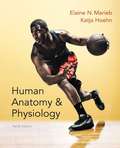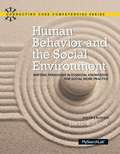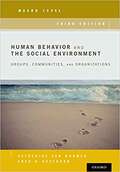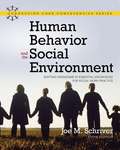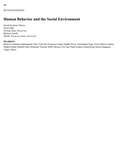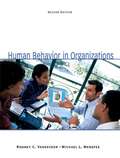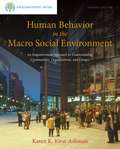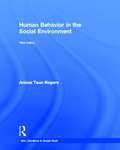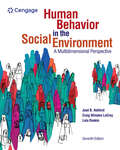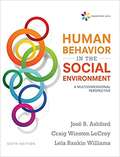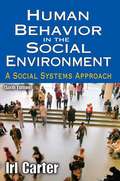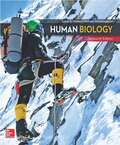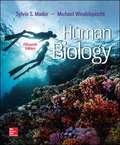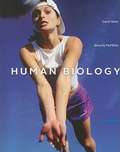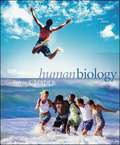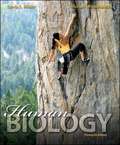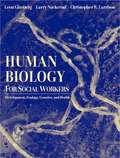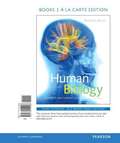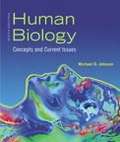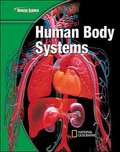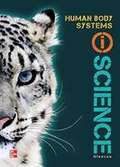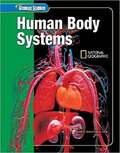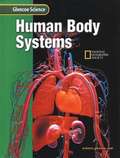- Table View
- List View
Human Anatomy and Physiology 10th Edition
by Elaine N. Marieb Katja HoehnHuman Anatomy and Physiology is organized under the following units : 1)Organization of the Body 2)Covering, Support, and Movement of the Body 3)Regulation and Integration of the Body and 4) Maintenance of the Body.
Human Behavior and The Social Environment: Shifting Paradigms in Essential Knowledge for Social Work Practice
by Joe M. SchriverHuman Behavior and the Social Environment, 6/e challenges students to explore both traditional and non-traditional paradigms in examining human behavior and the social environment. Through this examination, readers will better understand individuals, families, groups, organizations, communities and globalization. Students will recognize the range of social systems in which people live and the ways these systems promote or deter people in their health and wellbeing.
Human Behavior and the Social Environment, Macro Level: Groups, Communities, and Organizations
by Katherine Van Wormer Fred BesthornA timely revision in this global age, Human Behavior and the Social Environment, Macro Level develops a sophisticated and original view of the cultural, global, spiritual, and natural worlds that people inhabit, and explores the impact of these worlds on human behavior. An ecosystems/sustainability framework emerges as a key characteristic of contemporary practice. What is sustainable social work? What are the characteristics of a sustainable community? How is the present exploitation of environmental resources unsustainable for future generations? In accordance with the 2015 Council on Social Work Education (CSWE) standards, attention is paid to environmental justice as well as diversity and difference.
Human Behavior and the Social Environment: Shifting Paradigms in Essential Knowledge for Social Work Practice (5th edition)
by Joe M. SchriverThis textbook offers a comparative examination of competing paradigms in the study of human behavior and the social environment. The text focuses at each system level on the need for multiple perspectives that respect the diversity of persons and environments with whom social workers interact.
Human Behavior and the Social Environment: Social Systems Theory
by Rebecca Smith Orren DaleHuman Behavior and the Social Environment: Social Systems Theory provides an expanded treatment of systems theory, and applies the theory to common social work concerns. The text links systems to social roles, and provides a framework for critical assessment of the theories from the systems/roles perspective. It assesses the strengths and weaknesses of each theory with regard to the value of each theory for social work practice. <P><P> Social systems theory remains the focus of this text. In addition theories are identified as grand theories, middle range theories, or focal theories, to assist the student in understanding the scope and application of theories across system sizes. This text breaks new ground in using role theory as a middle range theory to address common features of human systems at a level that is more intuitive for students, and yet detailed enough to stimulate independent thinking. The text addresses the standard repertoire of theories, and in addition presents application of the theories to social issues such as violence and addiction.
Human Behavior in Organizations (Second Edition)
by Rodney C. Vandeveer Michael L. MenefeeThe goal of this book is to provide students with the basics of Human Behaviour in Organizations in a way that will help them envision how they will fit into organizations and be successful in their leadership roles.
Human Behavior in the Macro Social Environment: An Empowerment Approach to Understanding Communities,Fourth Edition
by Karen K. Kirst-AshmanFocusing on empowerment and stressing critical thinking, this book explores human behavior in task groups, organizations, and communities. The intent is to provide a sound knowledge base for understanding how the macro social environment works and make it easier for students to apply theory in subsequent practice courses.
Human Behavior in the Social Environment
by Anissa Taun RogersThis bestseller is ideal for use in either one-semester or year-long generalist human behavior courses. Why? Because the text is concise and easily used in a one-semester course. But the text also comes with a companion set of readings and five unique cases that encourage your students to "learn by doing" and to apply their knowledge of human behavior to best practices. Go to www.routledgesw.com/hbse to learn more. These additional resources easily allow you to use the text (and its related resources) in a two-semester sequence.
Human Behavior in the Social Environment: A Multidimensional Perspective
by José B. Ashford Craig Winston LeCroy Lela RankinAshford/LeCroy/Rankin's HUMAN BEHAVIOR IN THE SOCIAL ENVIRONMENT: A MULTIDIMENSIONAL PERSPECTIVE, 7th EDITION, is a comprehensive introduction to human behavior in the social environment that offers a multidimensional approach, with discussion of integrative practice, theory, treatment, diversity and services. You'll find solid coverage of foundation knowledge, material on the biopsychosocial dimensions for assessing social functioning, and case studies to illuminate the applied aspects of case formulation processes. This edition integrates the core competencies and recommended practice behaviors outlined in the Educational Policy and Accreditation Standards (EPAS) set by the Council on Social Work Education (CSWE). Study tables and concept maps clarify major phases of biopsychosocial development. This text's framework gives you a concrete tool for assessing human behavior from a social work professional perspective.
Human Behavior in the Social Environment: A Multidimensional Perspective (Empowerment Series)
by Craig Winston LeCroy Lela Rankin Williams Jose B. AshfordThis lively, comprehensive introduction to human behavior in the social environment offers a multidimensional approach, with discussion of integrative practice, theory, treatment, and services as well as matters pertaining to diversity. You'll find solid coverage of foundation knowledge, material on the biopsychosocial dimensions for assessing social functioning, and case studies to illuminate the applied aspects of case formulation processes. <p><p>The sixth edition integrates the core competencies and recommended practice behaviors outlined in the 2015 Educational Policy and Accreditation Standards (EPAS) set by the Council on Social Work Education (CSWE), helping you connect foundation knowledge with practice concerns. Study tables and concept maps clarify major phases of biopsychosocial development. In short, this text's framework gives you a concrete tool for assessing human behavior from a perspective that reflects the values and knowledge base of the social work profession.
Human Behavior in the Social Environment: A Social Systems Approach (Sixth Edition)
by Irl CarterSince the publication of the first edition of Human Behavior in the Social Environment, several generations of students have successfully used this classic text, which takes a social systems approach to human behavior. This systems approach is still widely accepted in the human services disciplines, including social work, education, nursing, psychology, and in human services programs themselves. Its ideas have become the organizing framework for curriculum, as well as fruitful sources for new applications of theory and practice. Among the advantages of the social systems approach is that it permits students and practitioners to see connections between fields of practice, between methods, and across professional disciplines and bodies of theory. The book serves as a template of the concentric circles of human behavior, with chapters on fields of behavior, beginning with the person and ranging outward to culture and society. Abundant examples from practice and from behavioral patterns are drawn from the social sciences, topical events, literature, and the authors’ personal and professional experiences. This volume responds to the needs of students and instructors as these have developed since the publication of the previous edition.
Human Biology
by Sylvia S. Mader Michael WindelspechtInstructors consistently ask for a Human Biology textbook that helps students understand the main themes of biology through the lens of the human body. Mader’s Human Biology accomplishes the goal of improving scientific literacy, while establishing a foundation of knowledge inhuman biology and physiology. The text integrates a tested, traditional learning system with modern digital and pedagogical approaches designed to stimulate and engage today’s student. <p><p>Dr. Michael Windelspecht represents the new generation of digital authors. Through the integration of an array of multimedia resources, Michael has committed to delivering the tried-and-true content of the Mader series to the new generation of digital learners. A veteran of the online, hybrid, and traditional teaching environments, Michael is well-versed in the challenges facing the modern student and educator.
Human Biology
by Sylvia S Mader<p>This revision of Human Biology, Fifteenth Edition, had the following goals: <p> <li>Updating of chapter openers, featured readings, and Connections content to focus on issues and topics important to this generation of students <li>Utilization of the data from the LearnSmart adaptive learning platforms to identify content areas within the text that students demonstrated difficulty in mastering <li>Refinement of digital assets to provide a more effective assess¬ment of learning outcomes to enable instructors in the flipped, online, and hybrid teaching environments <li>Development of a new series of videos and websites to intro¬duce relevancy and engage students in the content</li></p>
Human Biology (9th Edition)
by Beverly Mcmillan Cecie StarrPresenting core concepts in a relevant context, Starr and McMillan's HUMAN BIOLOGY gives you a clear understanding of how the human body works and helps you make well-informed choices as a consumer and voter. Each chapter opens with a human biology-related issue currently in the news that highlights the relevance of the topic. You then learn the basic concepts which help you think critically about these issues.
Human Biology (9th Edition)
by Sylvia S. MaderIn this edition, as in previous editions, each chapter presents the topic clearly and distinctly so that students will feel capable of achieving an adult level of understanding. Detailed, high-level scientific data and terminology are not included because Dr. Mader believes that true knowledge consists of working concepts rather than technical facility.
Human Biology (Thirteenth Edition)
by Sylvia S. Mader Michael WindelspechtInstructors consistently ask for a human biology textbook that helps students develop an understanding of the main themes of biology while placing the material in the context of the human body. Mader's Human Biology was developed to fill this void. To accomplish the goal of improving scientific literacy, while establishing a foundation of knowledge in human biology and physiology, Human Biology integrates a tested, traditional learning system with modern digital and pedagogical approaches designed to stimulate and engage today's student. Multimedia Integration: Michael Windelspecht represents the new generation of digital authors. Through the integration of multimedia resources, such as videos, animations and MP3 files, and in the design of a new series of guided tutorials, Dr Windelspecht has worked to bring Dr. Mader's texts to the new generation of digital learners. A veteran of the online, hybrid, and traditional teaching environments, Dr. Windelspecht is well versed in the challenges facing today's students and educators. Dr. Windelspecht guided all aspects of the Connect content accompanying Human Biology. The authors of the text identified several goals that guided them through the revision of Human Biology, Thirteenth Edition: build upon the strengths of the previous editions of the text, enhance the learning process by integrating content that appeals to today's students, deploy new pedagogical elements, including multimedia assets, to increase student interaction with the text, develop a new series of digital assets designed to engage the modern student and provide assessment of learning outcomes.
Human Biology for Social Workers: Development, Ecology, Genetics, and Health
by Leon Ginsberg Larry Nackerud Christopher LarrisonThis engaging and accessible supplemental text will give students a basic understanding of human biology and how it relates to human behavior and the social environment. It successfully integrates social work theory with human biology theory.
Human Biology: Concepts And Current Issues (Eighth Edition)
by Michael D. JohnsonThrough his teaching, his textbook, and in his online blog, award-winning teacher Michael D. Johnson sparks the interest of today’s science-intimidated student by connecting basic biology to real-world issues relevant to students' own lives. Through a storytelling approach and extensive online support, Human Biology: Concepts and Current Issues not only demystifies how the human body works but drives students to become better consumers of health and science information. Each chapter opens with Johnson’s popular "Current Issue" essays, and BlogInFocus references within the chapter direct students to his frequently-updated online blog for breaking human biology-related news.
Human Biology: Concepts and Current Issues (6th edition)
by Michael D. JohnsonAward-winning teacher Michael D. Johnson catches your interest immediately by connecting basic biology concepts to real-world issues that are relevant to your life. Through a storytelling approach and extensive online support, Human Biology: Concepts and Current Issues, 6th Edition not only demystifies how the human body works but helps you to become a better consumer of health and science information. Each chapter now opens with Johnson's popular "Current Issue" essays, and inside each chapter are entries from the author's own, frequently updated blog. Expanded online resources are now available and conveniently referenced in chapter sections with icons and URLs. The 6th Edition also offers you stronger self-assessment tools, with new and expanded critical-thinking questions throughout each chapter and in the end-of-chapter reviews.
Human Body Systems
by Glencoe Mcgraw-HillDiscover the Flexibility to Teach Science Your Way!. "Glencoe Science: Human Body Systems," a module in the Glencoe Science 15 book series, provides students with accurate and comprehensive coverage of middle school National Science Education Standards. Concepts are explained in a clear, concise manner, and are integrated with a wide range of hands-on experiences, critical thinking opportunities, real-world applications, and connections to other sciences and to non-science areas of the curriculum. Co-authored by National Geographic, unparalleled graphics reinforce key concepts. A broad array of print and technology resources help differentiate and accommodate all learners. The modular approach allows you to mix and match books to meet your specific curriculum needs.
Human Body Systems IScience
by Glencoe Mcgraw-Hill American Museum of Natural HistoryMiddle School Science
Human Body Systems: Book D (Glencoe Science)
by McGraw-Hill EducationHuman Body Systems, as a part of the Glencoe Science 15-Book Series, provides students with accurate and comprehensive coverage of the human body and its key organ systems. The strong content coverage integrates a wide range of hands-on experiences, critical-thinking opportunities, and real-world applications. The modular approach allows you to mix and match books to meet your curricula.
Human Body Systems: Course D
by McGraw-Hill Glencoe"Science meets students where they are through engaging features and thought-provoking questions that encourage them to relate the science concepts to the world around them.
